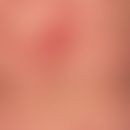Synonym(s)
HistoryThis section has been translated automatically.
DefinitionThis section has been translated automatically.
Rare, chronic, bullous, autoimmunological pregnancy dermatosis close to the bullous pemphigoid, occurring predominantly in the 2nd half of pregnancy or postpartum and characterized by the formation of large, usually considerably itchy inflammatory plaques and subepithelial blisters. Outside pregnancy the disease has been described in association with trophoblastic tumours (chorionic carcinoma, bladder mole).
You might also be interested in
Occurrence/EpidemiologyThis section has been translated automatically.
Incidence: 1: 10,000 to 1: 60,000 pregnancies/year. In Germany, the incidence is around 2 new cases per 1 million inhabitants/year.
EtiopathogenesisThis section has been translated automatically.
Formation of complement-fixing autoantibodies. Target antigen is the 180-kDa (BP 180) "bullous pemphigoid antigen = collagen XVII", in about 20% of cases the 230-kDa (BP 230), in the area of the hemidesmosomes of the dermoepidermal junction zone. This reactivity can be detected in the blood of the patients and the newborns. The cause of maternal autoantibody production is unclear. There is a correlation with the haplotypes HLA-DR3 and DR4.
Possibly a disease of the placenta is causative for the autoimmunological mechanism. This is suggested in particular by:
- Disease occurs only in pregnancy and in chorionic carcinoma and bladder mole.
- Circulating antibodies also bind to the basement membrane of the chorionic and amniotic epithelium.
- Aberrant expression of MHC class II molecules in the chorionic villi indicate an allogeneic immune response against placental matrix antigens of paternal origin (Sadik 2016).
- In the 2nd trimester BP180 can be detected in the amniotic epithelium.
ManifestationThis section has been translated automatically.
Mostly mid-trimester (average at 31 weeks in first gravidae and 21.2 weeks in multigravidae) or immediately post partum.
The average age of first-gravid patients in major studies is 30.5 years.
LocalizationThis section has been translated automatically.
Clinical featuresThis section has been translated automatically.
Usually, vesicular exanthema is preceded by generalized pruritus for several days or weeks. Skin lesions begin preferentially periumbilically with grouped or disseminated, 0.2-4.0 cm, intense red, urticarial papules and plaques. Occasionally, cocardiform formations develop. Usually formation of grouped (sometimes in herpetiform arrangement: see naming!) vesicles and turgid blisters only after several weeks (blister formation is not obligatory). Associations with other blistering autoimmune diseases (pemphigus) have been reported.
Mucous membranes: The mucous membranes usually remain free. There is no association with striae distensae.
Newborns: In 10% of cases, corresponding skin changes in the newborn are possible, usually mild (passive transplacental antibody transfer). These resolve spontaneously within a few weeks.
LaboratoryThis section has been translated automatically.
HistologyThis section has been translated automatically.
Direct ImmunofluorescenceThis section has been translated automatically.
Always linear complement deposits (C3) at the dermoepidermal junction zone. In about 1/3 of the cases analogous IgG, more rarely IgA and IgM deposits are detectable. With the salt separation method a 100% reactivity of C3 can be detected on the epidermal side of the salt-split preparation. The same antibodies are found in the infant's skin in the case of a co-infection.
Indirect immunofluorescenceThis section has been translated automatically.
Detection of circulating antibodies (so-called herpes-gestationis factor) with complement fixing properties. In routine investigations, pemphigoid antibodies are found in only about 20% of patients.
Differential diagnosisThis section has been translated automatically.
Complication(s)This section has been translated automatically.
Antibodies are diaplacentally transferable. 5-10% of infants may suffer from a more passable blister formation.
TherapyThis section has been translated automatically.
External therapyThis section has been translated automatically.
Internal therapyThis section has been translated automatically.
Use of oral antihistamines . Systemic antihistamines can be used if itching is severe. The older sedating antihistamines (e.g., dimetindene or clemastine 1 tbl./day) are considered safe even during the 1st trimester. Non-sedating antihistamines can be used in the 2nd/3rd trimester or during lactation (e.g., loratadine, cetericine).
In cases of significant eruption pressure with a considerable tendency to blistering as well as intolerable pruritus with sleep disturbances, non-halogenated glucocorticoids e.g. prednisolone in a dosage of 0.5-1.0 mg/kg bw/day p.o. are indicated. See below " Pregnancy, drug prescriptions".
In case of therapy resistance, IVIG has been successfully used several times.
In case of therapy resistance, immunapharesis may be necessary during pregnancy and intensified immunosuppressive therapy postpartum.
Other alternatives, such as intravenous shock therapy with cyclophosphamide, plasmapheresis, or dapsone are effective in refractory cases. However, use should be postpartum.
Progression/forecastThis section has been translated automatically.
Generally no vital risk for mother and child. A flare-up of the disease at the time of birth is not unusual (short-term increase in systemic therapy!). Spontaneous healing 2-3 weeks after delivery.
If the disease persists or manifests itself for the first time several weeks to months after delivery, a placental tumor should be ruled out.
Recurrences are possible in subsequent pregnancies, under hormonal contraception or with the onset of menses. Caution with progestogen-containing contraceptives post partum. Risk of developing autoimmune diseases appears to be increased.
The prognosis for the child is favorable. In 20% of cases, increased premature birth rate and the development of so-called "small-fordate babies" (chronic placental insufficiency).
Note(s)This section has been translated automatically.
Pemphigoid gestationis favors the development of placental insufficiency and leads to underweight newborns (small-for-date babies). There is also an increased premature birth rate. Careful pregnancy monitoring is important. Outpatient gynecological treatment and integration into a clinic with an infant intensive care unit are recommended. Mild skin changes occur in around 10% of newborns as a result of passive transplacental antibody transfer, which subside within a few days.
LiteratureThis section has been translated automatically.
- Al-Fouzan AW et al (2006) Herpes gestationis (Pemphigoid gestationis). Clin Dermatol 24: 109-112
- Ambros-Rudolph CM (2006) Dermatoses of pregnancy. J Dtsch Dermatol Ges 4: 748-759
- Ambros-Rudolph CM (2010) Specific pregnancy dermatoses. Dermatologist 61: 1014-1020
- Ambros-Rudolph CM (2017) Specific pregnancy dermatoses. Dermatologist 68: 87-94
- Boulinguez S et al (2003) Chronic pemphigoid gestationis: comparative clinical and immunopathological study of 10 patients. Dermatology 206: 113-119
- Fabbri P et al (2003) The role of T lymphocytes and cytokines in the pathogenesis of pemphigoid gestationis. Br J Dermatol 148: 1141-1148
- Huilaja L et al.(2014) Gestational pemphigoid. Orphanet J Rare Dis9:136.
- Loo WJ, Dean D, Wojnarowska F (2001) A severe persistent case of recurrent pemphigoid gestationis successfully treated with minocycline and nicotinamide. Clin Exp Dermatol 26: 726-727
- Ko BJ et al (2014) Intravenous Immunoglobulin Therapy for Persistent PemphigoidGestationis
with Steroid Induced Iatrogenic Cushing's Syndrome. Ann Dermatol 26:661-663 - Sadik CD et al (2016) Pemphigoid gestationis: Toward a better understanding of the etiopathogenesis.
Clin Dermatol 34:378-82. - Shimanovich I et al (2002) Pemphigoid gestationis with predominant involvement of oral mucous membranes and IgA autoantibodies targeting the C-terminus of BP180. J Am Acad Dermatol 47: 780-784
- Sitaru C et al (2003) Pemphigoid gestationis: maternal sera recognize epitopes restricted to the N-terminal portion of the extracellular domain of BP180 not present on its shed ectodomain. Br J Dermatol 149: 420-422
- Tani N et al (2015) Clinical and immunological profiles of 25 patients with pemphigoid gestationis. Br J Dermatol 172:120-129
- Vin H et al (2016) Concomitant pemphigus vulgaris andpemphigoid
gestationis: a case report and review of the literature. Dermatol Online J 22.
Incoming links (11)
Antiandrogen-oestrogen combinations; Autoimmune dermatoses, bullous; DST Gene; Gestagens; Hydrocortisone emulsion hydrophilic 0.5-1; Newborns, skin changes; Pregnancy dermatosis, atopic; Pregnancy dermatosis polymorphic; Pregnancy scholestasis; Spongiosis; ... Show allOutgoing links (14)
Cyclophosphamide; Dadps; Dermatitis herpetiformis; Erythema multiforme; Glucocorticosteroids systemic; Glucorticosteroids topical; Hydrocortisone emulsion hydrophilic 0.5-1; Ivig; Linear IgA dermatosis; Pemphigoid bullous; ... Show allDisclaimer
Please ask your physician for a reliable diagnosis. This website is only meant as a reference.























